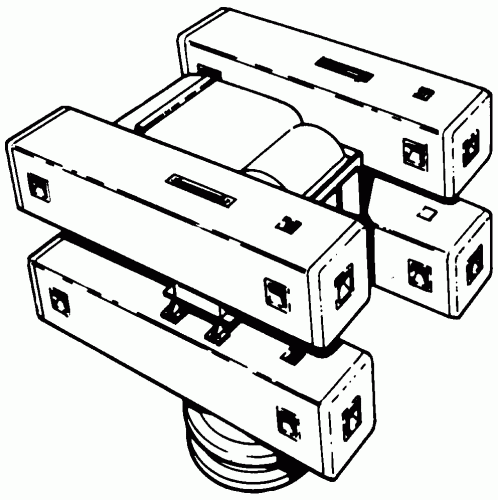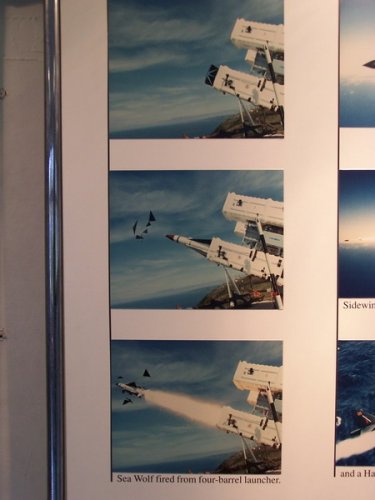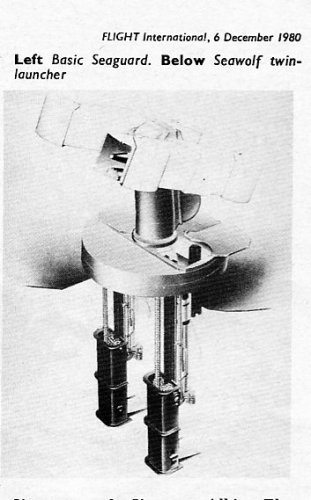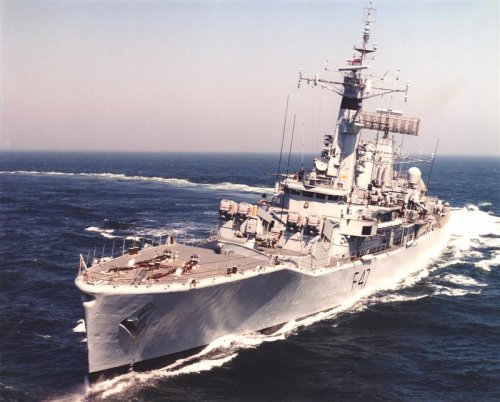You are using an out of date browser. It may not display this or other websites correctly.
You should upgrade or use an alternative browser.
You should upgrade or use an alternative browser.
Sea Wolf and Sea Dart: Unbuilt Derivatives and Cancelled Applications
- Thread starter TinWing
- Start date
- Joined
- 3 January 2006
- Messages
- 1,105
- Reaction score
- 709
Re: Sea Wolf and Sea Dart
The "Lightweight" Sea Wolf system nearly came to fruition. Although the missile was unmodified, the plan was to use a converted 4-round Sea Cat laucher without any automatic reloading facility. The plans was to fit two 4-round launchers to the Type 42 destroyers and an astounding total of four(!) launchers to the Invincilble class carriers.
Operational experience in the Falklands had indicated the value of having both Sea Dart and Sea Wolf in the same hull. Unfortunately, the existing 6-cell
The "Lightweight" Sea Wolf was cancelled in the early 1990s due to post-Cold War defense cuts.
The "Lightweight" Sea Wolf system nearly came to fruition. Although the missile was unmodified, the plan was to use a converted 4-round Sea Cat laucher without any automatic reloading facility. The plans was to fit two 4-round launchers to the Type 42 destroyers and an astounding total of four(!) launchers to the Invincilble class carriers.
Operational experience in the Falklands had indicated the value of having both Sea Dart and Sea Wolf in the same hull. Unfortunately, the existing 6-cell
The "Lightweight" Sea Wolf was cancelled in the early 1990s due to post-Cold War defense cuts.
Re: Sea Wolf and Sea Dart
Thanks for posting the link.
*** Chastises self for not having done it himself ***
There are two other items related to this - one showing the GWS 27 phased array tracker for an updated SeaWolf, and the other giving some details of the SeaCat derived LWSW launcher - but I didn't have them to scan.
RP1
Thanks for posting the link.
*** Chastises self for not having done it himself ***
There are two other items related to this - one showing the GWS 27 phased array tracker for an updated SeaWolf, and the other giving some details of the SeaCat derived LWSW launcher - but I didn't have them to scan.
RP1
- Joined
- 27 December 2005
- Messages
- 16,924
- Reaction score
- 21,798
Re: Sea Wolf and Sea Dart
http://rapidshare.de/files/17927143/1980s_Missiles.zip.html
http://rapidshare.de/files/17927143/1980s_Missiles.zip.html
- Joined
- 2 January 2006
- Messages
- 657
- Reaction score
- 261
Re: Sea Wolf and Sea Dart
Possibly to enable direct replacement of SeaCat launchers without having create space in the hull or build on additional deckhouse.s It was afterall supposed to be a close range system to complement the main stream Sea Dart system. Trouble was the Radar, trackers and launcgers proved to be too bulky that a lighter weight system had to be developed after to allow it to fullfill its intended purpose.....
PMN1 said:Anyone here know why the initial vertical launch version was dropped and the design changed to launch from a trainable 6-cell launcher?
Possibly to enable direct replacement of SeaCat launchers without having create space in the hull or build on additional deckhouse.s It was afterall supposed to be a close range system to complement the main stream Sea Dart system. Trouble was the Radar, trackers and launcgers proved to be too bulky that a lighter weight system had to be developed after to allow it to fullfill its intended purpose.....
Re: Sea Wolf and Sea Dart
Thats what I had read elsewhere as well, intrestingly I have also read that the specifications for the radar etc did not actually specify keeping weight down.....
Thorvic said:PMN1 said:Anyone here know why the initial vertical launch version was dropped and the design changed to launch from a trainable 6-cell launcher?
Possibly to enable direct replacement of SeaCat launchers without having create space in the hull or build on additional deckhouse.s It was afterall supposed to be a close range system to complement the main stream Sea Dart system. Trouble was the Radar, trackers and launcgers proved to be too bulky that a lighter weight system had to be developed after to allow it to fullfill its intended purpose.....
Thats what I had read elsewhere as well, intrestingly I have also read that the specifications for the radar etc did not actually specify keeping weight down.....
Re: Sea Wolf and Sea Dart
Does anyone have details or pictures of the proposed Sea Wolf SAM to the Invincible and Type 42 classes.
Also was the proposed 2 round launcher automatically reloaded or manually? How many missiles per launcher?
Does anyone have details or pictures of the proposed Sea Wolf SAM to the Invincible and Type 42 classes.
Also was the proposed 2 round launcher automatically reloaded or manually? How many missiles per launcher?
- Joined
- 3 January 2006
- Messages
- 1,105
- Reaction score
- 709
Re: Sea Wolf and Sea Dart
The definitive "Lightweight" Sea Wolf VM40 involved a 4-round converted Sea Cat launcher, but it appears that it was to have been offered with either automatic or manual reloading, depending on the application. Type 42 destroyers would have had two 4-round launchers, although it is hard to imagine where they would have fit on Batch 1 and 2 ships?
Invincible class carriers would have been fitted with a total of 4 launchers, and Jane's Defense Weekly did publish a deck plan showing the placement of the launchers and the HSA STIR directors. Oddly, the already large island would have been extended even farther aft to accomdate a pair of STIRs, and a considerable portion of the forward flight deck would have been taken up by the forward pair of 4-round lauchers.
PG_69 said:Does anyone have details or pictures of the proposed Sea Wolf SAM to the Invincible and Type 42 classes.
Also was the proposed 2 round launcher automatically reloaded or manually? How many missiles per launcher?
The definitive "Lightweight" Sea Wolf VM40 involved a 4-round converted Sea Cat launcher, but it appears that it was to have been offered with either automatic or manual reloading, depending on the application. Type 42 destroyers would have had two 4-round launchers, although it is hard to imagine where they would have fit on Batch 1 and 2 ships?
Invincible class carriers would have been fitted with a total of 4 launchers, and Jane's Defense Weekly did publish a deck plan showing the placement of the launchers and the HSA STIR directors. Oddly, the already large island would have been extended even farther aft to accomdate a pair of STIRs, and a considerable portion of the forward flight deck would have been taken up by the forward pair of 4-round lauchers.
Re: Sea Wolf and Sea Dart

And this is for the various containerized versions of Seawolf:

In both of these drawings two pixels equal one foot. The containers were to have been based on the standard international shipping container, and the two-round launcher had another two rounds below deck at the ready for reload. IIIRC after that the rounds had to be manually placed into the reloading positions.
I've got some pdf's *somewhere* on my HD, but I'll have to look. What I DO have right now is a drawing of how a T42 with Seawolf would have looked like:PG_69 said:Does anyone have details or pictures of the proposed Sea Wolf SAM to the Invincible and Type 42 classes.
Also was the proposed 2 round launcher automatically reloaded or manually? How many missiles per launcher?

And this is for the various containerized versions of Seawolf:

In both of these drawings two pixels equal one foot. The containers were to have been based on the standard international shipping container, and the two-round launcher had another two rounds below deck at the ready for reload. IIIRC after that the rounds had to be manually placed into the reloading positions.
M. A. Rozon
ACCESS: Confidential
- Joined
- 17 February 2007
- Messages
- 111
- Reaction score
- 58
First of all, first post for me after joining the board. As always, I start by asking questions! 
First, for Mihoshik, great rendition of the Type 42 with Seawolf (Good work, as always!). It matches the impression I always got whenever I read what little I could get my hands on. I am wondering if internal space issues might require some kind of small superstructure block between the Seawolf directors for related equipment and perhaps to prevent EMI between the directors.
Second, for TinWing and others, is it possible to get a copy of that LD for the Invincible with the Seawolf setup you saw in Jane's somewhere?
Thirdly, for Overscan, the rapidshare post mentioned earlier in this thread isn't there. Is it possible to obtain those brochures and info on Sea Wolf/ Sea Dart?
Thanks to all in advance. Looking forward to further participation.
Regards.
8)
First, for Mihoshik, great rendition of the Type 42 with Seawolf (Good work, as always!). It matches the impression I always got whenever I read what little I could get my hands on. I am wondering if internal space issues might require some kind of small superstructure block between the Seawolf directors for related equipment and perhaps to prevent EMI between the directors.
Second, for TinWing and others, is it possible to get a copy of that LD for the Invincible with the Seawolf setup you saw in Jane's somewhere?
Thirdly, for Overscan, the rapidshare post mentioned earlier in this thread isn't there. Is it possible to obtain those brochures and info on Sea Wolf/ Sea Dart?
Thanks to all in advance. Looking forward to further participation.
Regards.
8)
- Joined
- 3 January 2006
- Messages
- 1,105
- Reaction score
- 709
At long last, here is photographic proof that the definitive "Lightweight" Sea Wolf proposal involved a 4-round launcher and got as far as firing trials before cancellation.
The picture is from a book on the Falklands, although this system was cancelled far later during under the Major government.
The picture is from a book on the Falklands, although this system was cancelled far later during under the Major government.
- Joined
- 3 January 2006
- Messages
- 1,105
- Reaction score
- 709
smurf said:Are you sure that is a photograph?
I sure looks like a photograph to me.
- Joined
- 3 January 2006
- Messages
- 1,105
- Reaction score
- 709
I can still remember the first version of Adobe Photoshop, back at the beginning of the 1990s.
So, does the this image predate Photoshop? Probably not.
If you have some reason to believe that this image is doctors, please offer your insights?
So, does the this image predate Photoshop? Probably not.
If you have some reason to believe that this image is doctors, please offer your insights?
Disclosure
ACCESS: Restricted
- Joined
- 31 December 2006
- Messages
- 8
- Reaction score
- 3
That is a genuine photograph taken at the RAE Aberporth range - I was there.
I have somewhere an additional document with technical information on the 4-round launcher. Unfortunately I'm not sure where it is, so it wasn't included in the original 18MB "package". IIRC this document states that the system was based on the Sea Cat launcher, and had been demonstrated. A very low quality copy of the colour phot is in one of the PDFs, but it's nice to see it in full colour.
RP1
RP1
Great. Sorry to have raised any doubts, but there are a lot of 'artist's impressions' around, and some are hard to tell. I had no other grounds than 'this looks too good to be true' (and that my wife could have added the missile to the launcher these days!). I'm glad it's genuine. Apologies for the red herring.That is a genuine photograph taken at the RAE Aberporth range - I was there.
- Joined
- 3 January 2006
- Messages
- 1,105
- Reaction score
- 709
RP1 said:I have somewhere an additional document with technical information on the 4-round launcher. Unfortunately I'm not sure where it is, so it wasn't included in the original 18MB "package". IIRC this document states that the system was based on the Sea Cat launcher, and had been demonstrated. A very low quality copy of the colour phot is in one of the PDFs, but it's nice to see it in full colour.
RP1
I see that in your 3 page "Lightweight Seawolf.pdf" there is a diagram of the (manually reloaded) 4-round laucher labeled "Rose Forgrove?"
It seems that former Aeromarine division of Rose Forgrove at Gainsborough was involved in producing Sea Cat launchers. Today, this company still produces industrial equipment, such as "flow wrapping machines."
Now, the odd thing is that Rose Forgrove supposedly withdrew from the defense business in 1985, well over 6 years before "Lightweight Seawolf" was cancelled, albeit while retaining the capacity to produce the 4-round launchers if an order did materialize. Perhaps the Lighweight Seawolf program had been delayed for many years before its official demise?
Here is (rather boring) corporate history page:
http://www.bphs.net/GroupFacilities/R/RoseBrothersGainsborough.htm
Here is a somewhat larger version of the same drawing, from the same book as the firing trials photo.
Attachments
- Joined
- 21 December 2006
- Messages
- 1,148
- Reaction score
- 741
As I understand it, LW SeaWolf would have used modified Sea Cat launchers, which might explain the dates difference.
In "International Defence Review" 4/1988, Page 443, there is a short item with a picture of the 4 round LWSW launcher being fired (a reverse angle on the one earlier in this thread). The following points are made:
• Royal Navy ordered GWS26Mod2 - Lightweight Sea Wolf - for 3 CVS and 4 T42 Batch III
• £40million fixed price contract
• Contract covers completion of the development that started in 1981 and production
• Complete LWSW programme costed about £100million
• Marconi = Trackers
• Ferranti = Processing (computers)
• AVP-Baker Perkins = Launchers
• Launcher developed from Sea Cat
• IDR "understands" that CVS = 4 LCR, 2 911(3) trackers, and T42BIII = 2 LCR & 2 911(3)
A short chapter to add to the story...
RP1
• Royal Navy ordered GWS26Mod2 - Lightweight Sea Wolf - for 3 CVS and 4 T42 Batch III
• £40million fixed price contract
• Contract covers completion of the development that started in 1981 and production
• Complete LWSW programme costed about £100million
• Marconi = Trackers
• Ferranti = Processing (computers)
• AVP-Baker Perkins = Launchers
• Launcher developed from Sea Cat
• IDR "understands" that CVS = 4 LCR, 2 911(3) trackers, and T42BIII = 2 LCR & 2 911(3)
A short chapter to add to the story...
RP1
Excellent. Any mention of Psi, Omega or Delta variants in this article?
No, it's just a short update on a then-current project. The names ring a bell, but I suspect they were internal designators.
Information on GWS.27:
• Replacement of each 911 with a phased array "under consideration"
• Each array covers 90 degrees, and is steered and elevated on a fitting closely resembling the existing 911 base
• Marconi proposal for the new tracker has an "office" below the tracker approx 1/4 the area of the 911 office
• Phased array in this case is a square array slightly larger than the circular guidance radar component on 911
• Tracker to provide initial guidance data, missile to then lock on active homing head and engage the target
• Tracker would then be released for the next engagement
• Stated to be in "pre feasibility studies"
Source:
Edwards, R J (Lt-Cdr, RN), "Seawolf SITREP", Journal of Naval Engineering, Vol. 30, No. 1
red admiral
ACCESS: Top Secret
- Joined
- 16 September 2006
- Messages
- 1,622
- Reaction score
- 1,898
Mercurius Cantabrigiensis
ACCESS: Restricted
- Joined
- 8 November 2007
- Messages
- 46
- Reaction score
- 19
One reason for abandoning vertical launch when the original GWS 25 version of Seawolf was designed may have been that vertical launch puts the missile were it is not wanted – high above the ship. To cope with a sea-skimming target at short range, a trainable launcher would have been more useful, reducing the amount of manoeuvring that the round would have to do immediately after launch.
(When a Seawolf VL missile is fired against a sea-skimming threat, the missile flips over into a nose-down position while not much higher than the ship, so that the booster can kill the missile’s vertical velocity and drive to down to near sea level.)
(When a Seawolf VL missile is fired against a sea-skimming threat, the missile flips over into a nose-down position while not much higher than the ship, so that the booster can kill the missile’s vertical velocity and drive to down to near sea level.)
I'll need to check with my boss (involved with T23 design), but IIRC that's actually an SSM on the upper drawing.
RP1
RP1
Also, the lack of a main gun is because, until lessons were learned from the Falklands, guns were seen as being of little use. SSMs were needed since an ASW tug would be operating far enough away from a task force that it might encounter it's opposite numbers - Krivaks, for instance.
RP1
RP1
Brickmuppet
ACCESS: Secret
If a SSM was needed I'd think they'd use Harpoon, Exocet or Penguin.
I think the multibarreled weapon on the proto-type23 is an ASW rocket launcher. If so its probably the Swedish system firing ERICA. I can't see 4 seadarts being terribly useful and they'd require a similar director and search radar to a larger ship with a full magazine.
Remember, this raison d'etre of this design at this stage was austerity.
Of course DK Brown and company were very good at thinking out of the box, so there may have been a
rationale that I'm missing.
Any thoughts?
I think the multibarreled weapon on the proto-type23 is an ASW rocket launcher. If so its probably the Swedish system firing ERICA. I can't see 4 seadarts being terribly useful and they'd require a similar director and search radar to a larger ship with a full magazine.
Remember, this raison d'etre of this design at this stage was austerity.
Of course DK Brown and company were very good at thinking out of the box, so there may have been a
rationale that I'm missing.
Any thoughts?
- Joined
- 16 April 2008
- Messages
- 9,051
- Reaction score
- 12,820
No, the launcher in that first design is definitely for SSMs, not Sea Dart or an ASW weapon. Norman Friedman's British Frigates and Destroyers notes that "the earliest version of the Type 23 design was 100m long, with SSMs forward and lightweight torpedo tubes amidships." I believe D.K. Brown's Rebuilding the Royal Navy says much the same, but I can't lay hands on my copy at the moment.
Using a director, which the early T23 does not have.
RP1
It has to be a SSM of the Exocet/Harpoon ilk. There is not evidence on the sketch of a guidance radar, just the search radar, which looks like a 967/8, SCOT aerials and various smaller devices, no sign of a Type 911 radar, which would surely have be added if the illustrator has gone to the effort of adding SCOT.
(To RP1, looks like we had the same idea at the same time)
(To RP1, looks like we had the same idea at the same time)
Just checked with my boss, David Andrews (worked with DKB on early T23 studies in Future Projects, on CVS, amphibs and FE/FSC before leaving MoD to come back to UCL), and they were Exocet cannisters.
Regards,
RP1
Regards,
RP1
Just as a note - according to Friedman, MM-40, which can use the smaller cannister, began production in 1981 (1). This is consistent with the use of MM-40 for what became the T23.
RP1
(1) http://books.google.com/books?id=l-DzknmTgDUC&pg=PA226&lpg=PA226
RP1
(1) http://books.google.com/books?id=l-DzknmTgDUC&pg=PA226&lpg=PA226
Last edited by a moderator:
- Joined
- 3 January 2006
- Messages
- 1,105
- Reaction score
- 709
RP1 said:Just checked with my boss, David Andrews (worked with DKB on early T23 studies in Future Projects, on CVS, amphibs and FE/FSC before leaving MoD to come back to UCL), and they were Exocet cannisters.
Regards,
RP1
Well that solves it.
It strikes me that the drawings in question are poorly rendered, as I've never seen Exocet cannisters placed on (what appears to be) a pedestal. I also was confused by the near horizontal angle of the cannisters themselves.
I'll delete my previous posts to avoid any future confusion.
- Joined
- 2 January 2006
- Messages
- 657
- Reaction score
- 261
TinWing said:RP1 said:Just checked with my boss, David Andrews (worked with DKB on early T23 studies in Future Projects, on CVS, amphibs and FE/FSC before leaving MoD to come back to UCL), and they were Exocet cannisters.
Regards,
RP1
Well that solves it.
It strikes me that the drawings in question are poorly rendered, as I've never seen Exocet cannisters placed on (what appears to be) a pedestal. I also was confused by the near horizontal angle of the cannisters themselves.
I'll delete my previous posts to avoid any future confusion.
Possibly they were considering the MM40 Exocet on a trainable mount to replace the rather bulky fixed MM-39 canisters as those atke up rather alot of space for just four missiles.
- Joined
- 16 April 2008
- Messages
- 9,051
- Reaction score
- 12,820
Thorvic said:Possibly they were considering the MM40 Exocet on a trainable mount to replace the rather bulky fixed MM-39 canisters as those atke up rather alot of space for just four missiles.
Trainable mounts would make no sense for MM40 -- one of its main selling points was the ability to turn though 90 degrees once it left the launcher, sharply reducing the need to point the ship or launcher at the target.
IMO, this is probably just an artist's best guess at what the MM40 launcher would look like done a year or two before it was finalized. The rather tall pedestal base and low angle installation are really not that different from the typical RN installation for MM38; it's very reminiscent of the mount in the Exocet Leander, for instance (see attached). In reality, the MM40 launcher turned out to be less extensive, but still at a lower angle than the Harpoon Mk141 launcher.
Attachments
Similar threads
-
60s Point Defence Missiles: Mauler and the UK PT 428
- Started by uk 75
- Replies: 4
-
Alternate 80s Britain: How would the services cope?
- Started by uk 75
- Replies: 3
-
Strategic Air Command in the UK - Robert S. Hopkins III
- Started by CJGibson
- Replies: 2
-
British alternative to NATO INF (Cruise and Polaris)
- Started by uk 75
- Replies: 10
-
The 1968 French civil war and it's aftermath
- Started by Michel Van
- Replies: 28




